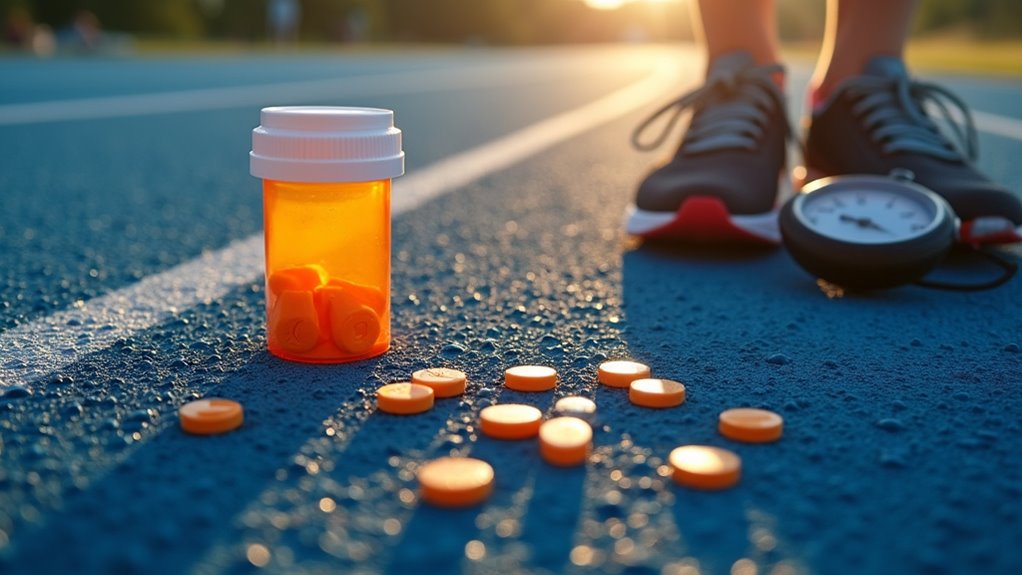Suboxone can markedly affect your athletic performance through multiple mechanisms. You’ll experience changes in energy levels, respiratory function, and recovery processes during treatment. The medication’s partial opioid effects may limit your cardio endurance and slow reaction times, while potentially causing muscle recovery issues and fatigue. However, with proper monitoring and adjusted training strategies, you can maintain athletic activities throughout treatment. Understanding these impacts helps develop effective adaptation strategies for ideal performance.
Understanding Suboxone’s Impact on Athletic Performance

While athletes undergoing Suboxone treatment can maintain competitive performance, understanding the medication’s complex effects on athletic capability is pivotal for ideal training outcomes. You’ll experience variable energy profiles that require careful energy balance adjustments, as Suboxone’s partial agonist effects may impact your training intensity. The combination of buprenorphine and naloxone helps athletes manage withdrawal symptoms while maintaining their fitness regimen.
Your respiratory function might show some limitations, particularly during sustained aerobic activities. Regular exercise can help reduce withdrawal symptom intensity during tapering periods. Early treatment phases may lead to reduced physical activity due to flu-like symptoms. To optimize performance, you’ll need to focus on dietary supplementation strategies while managing potential metabolic changes, including sugar cravings and water retention. The medication’s influence on pain perception requires vigilant monitoring of your exertion levels to prevent overtraining.
In addition, you’ll benefit from emphasizing anaerobic or low-impact activities that align with your body’s adapted capabilities under Suboxone treatment.
Physical Side Effects Athletes Should Monitor

When taking Suboxone, you’ll need to carefully monitor your cardiorespiratory function, as respiratory depression and irregular heart rates can substantially limit your endurance capacity during training and competition. Excessive sweating during physical activity is a common side effect that may increase dehydration risk.
Your muscle recovery timeline may be extended due to the medication’s effects on fatigue, weakness, and temperature regulation, requiring adjustments to your usual training intensity and rest periods. Side effects like headache and nausea can interfere with maintaining proper nutrition and hydration needed for optimal athletic performance. Athletes should be aware that Suboxone is a controlled substance that requires special physician oversight and monitoring.
The drug’s neurological effects, including dizziness and concentration difficulties, can impair your reaction time and coordination – critical factors that directly impact athletic performance and safety during sports activities.
Cardio Endurance Challenges
Athletes undergoing Suboxone treatment face distinct cardio endurance challenges that require careful monitoring and strategic adaptations. Your respiratory capacity optimization becomes essential as buprenorphine’s partial respiratory depression can affect sustained aerobic activities.
You’ll need to implement prolonged fatigue mitigation strategies while maintaining awareness of altered pain perception that might mask overexertion signals during intense cardio sessions.
- Monitor your lactate thresholds carefully and incorporate additional rest periods during endurance training
- Adjust your pacing strategies for activities like marathon running or swimming to accommodate potential breathing limitations
- Maintain consistent heart rate monitoring to guarantee optimal training load and prevent overexertion
Your energy levels may fluctuate, but you can maintain effective cardio performance by adapting workout intensity and duration while following proper warm-up and cool-down protocols.
Managing Muscle Recovery Issues
Successful muscle recovery during Suboxone treatment demands vigilant monitoring of specific physical side effects that can impact athletic performance. You’ll need to address common challenges like prolonged muscle soreness, fatigue, and potential peripheral edema that can delay tissue repair and regeneration.
Implementing hydration optimization strategies becomes essential, as Suboxone-related issues like constipation and burnt mouth syndrome may compromise your fluid intake. Focus on diet modifications for recovery, particularly when nausea or appetite changes affect your protein consumption.
Watch for withdrawal-related symptoms during tapering periods, as muscle cramps and tremors can interfere with recovery protocols. Monitor your sleep quality, as Suboxone-induced drowsiness and insomnia can impair muscle repair processes. Address mood fluctuations that might disrupt your recovery routine, and maintain consistent communication with your healthcare provider about these symptoms.
Reaction Time Limitations
Beyond muscle recovery concerns, Suboxone’s impact on reaction time creates distinct performance challenges for competitive athletes. Research shows you’ll likely experience slower reaction times, with studies documenting an average delay of 99 milliseconds compared to controls. These executive function deficits can affect your competitive edge, particularly in sports requiring split-second decisions. The medication’s partial opioid activation helps maintain stable brain chemistry during exercise. Your reaction speed may decrease markedly during initial treatment phases, with documented slower responses in cognitive performance tests. The medication’s buprenorphine and naloxone combination helps manage opioid dependency while maintaining focus during training. The long-term use of Suboxone may cause poor decision-making that could impact gameplay strategies. You’ll need to monitor impulse control issues, as data shows increased commission errors during attention-demanding tasks. Your medication duration matters longer treatment correlates with improved reaction times (-0.52 to -0.57 CI).
While these limitations can impact performance, evidence suggests cognitive function typically improves with sustained, properly-dosed treatment.
Drug Interactions and Safety Concerns

When you’re taking Suboxone, you’ll need to exercise extreme caution with stimulants and pre-workout supplements, as these combinations can trigger dangerous cardiovascular effects and unpredictable drug interactions.
Common athletic supplements, including St. John’s Wort and certain protein formulations, may interfere with Suboxone’s metabolism and effectiveness, requiring careful evaluation by your healthcare provider. Alcohol interactions require special attention during Suboxone treatment, as there is a documented risk of dangerous side effects when combining these substances. Taking Suboxone with certain medications like benzodiazepines can lead to severe drowsiness and increased overdose risk. Since Suboxone can cause lightheadedness and nausea, it’s important to start with less intense workouts to prevent injury.
You must maintain detailed records of any substances you’re using alongside Suboxone and report unusual symptoms immediately, as even seemingly harmless supplements can create potentially life-threatening interactions with this medication.
Heightened Risks With Stimulants
The concurrent use of stimulants and Suboxone presents significant medical risks that require careful consideration and monitoring. You’ll face heightened dangers when combining these substances, as they can create unpredictable effects on your central nervous system. Even without direct pharmacological interactions, the combination can lead to compounded sedation risks and complicate withdrawal symptom management. Since narcotic analgesic combinations encompass the drug classification of Suboxone, understanding medication categories is crucial for treatment safety. The opposing effects of central nervous system stimulants and depressants make this combination particularly dangerous.
Critical safety concerns you must understand:
- The “speedball” effect can mask dangerous respiratory depression, increasing overdose risk
- Your body may experience amplified side effects, including severe anxiety and cardiovascular strain
- Standard withdrawal protocols become less effective due to competing drug actions
You’ll need frequent medical oversight and imperative sign monitoring if you’re prescribed both medications. Always disclose your complete medication history to healthcare providers to guarantee proper treatment adjustments and safety protocols.
Common Supplement Safety Concerns
Understanding supplement interactions with Suboxone requires careful consideration of potential risks and safety concerns. You’ll need to exercise extreme caution with herbal supplements, as many can interfere with your treatment’s effectiveness and safety. St. John’s Wort, in particular, can reduce Suboxone’s efficacy through liver enzyme interactions, while kratom poses dangerous respiratory depression risks. You must also note that combining supplements with Suboxone while consuming alcoholic beverages is dangerous.
Regular liver enzyme monitoring is essential when taking supplements alongside Suboxone. Common herbal contraindications include sedative herbs like valerian root, which can intensify CNS depression. You should always disclose any supplements to your healthcare provider, as many products lack sufficient safety data. Watch for signs of liver strain, especially with unregulated supplements or those known to affect hepatic function. Avoid supplements without clear ingredient profiles or safety documentation.
Monitoring Mixed Substance Use
Safe Suboxone treatment requires vigilant monitoring of three critical drug interaction categories: CNS depressants, metabolic modulators, and neurotransmitter-affecting substances. You’ll need to maintain strict medication adherence while avoiding substances that could compromise your athletic performance or safety. Behavioral therapies can help you identify and manage potential drug interactions during treatment.
CNS depressants like benzodiazepines, alcohol, and muscle relaxers greatly impair coordination and increase respiratory depression risks.
Metabolic interactions with medications like Paxlovid or herbal supplements can alter Suboxone levels unpredictably, requiring dose adjustments.
Neurotransmitter-affecting substances, including SSRIs and antipsychotics, may increase sedation and serotonin syndrome risks, impacting athletic performance.
Work closely with your healthcare provider to monitor these interactions and maintain ideal treatment outcomes.
Managing Treatment While Training
Successful management of Suboxone treatment while maintaining an athletic training regimen requires careful attention to both physical and neurological factors. You’ll need to implement specific motivation strategies while making nutritional adjustments to accommodate energy fluctuations and recovery needs.
Start with low-impact activities and gradually increase intensity based on your body’s response. Schedule workouts during your peak energy windows and incorporate mindfulness exercises to optimize performance. You’ll need to monitor your hydration levels closely and adjust your caloric intake to support increased physical demands.
Work with medical professionals to track your respiratory function and pain perception changes. Consider incorporating recovery techniques like foam rolling to address muscle stiffness, and prioritize quality sleep to facilitate physical adaptation. Regular assessments will help prevent overtraining and promote safe progression in your athletic development.
Mental Health and Performance Considerations
Mental health challenges among athletes require specialized attention when managing Suboxone treatment alongside performance goals. The combination of psychological rehabilitation and ongoing athletic training demands a careful balance to maintain emotional stability and peak performance. Research shows that integrating exercise during treatment can markedly enhance mental health outcomes while supporting recovery.
You’ll experience reduced withdrawal symptoms that could disrupt training, as Suboxone helps regulate stress responses and stabilize cognitive function during high-pressure situations.
Regular physical activity during treatment strengthens your mental resilience, improving sleep quality and augmenting self-esteem pivotal for sustained performance.
The medication’s ability to address underlying mental health triggers helps prevent performance deterioration commonly associated with untreated psychological conditions, particularly during injury recovery or career shifts.
Best Practices for Athletes Using Suboxone
Effective management of Suboxone treatment while pursuing athletic excellence requires precise protocols and systematic monitoring. You’ll need to establish clear medication administration protocols in coordination with your sports medicine team and maintain consistent dosing schedules to maximize performance outcomes.
Implement injury rehabilitation strategies that account for Suboxone’s effects on your body, including modified exercise intensities and extended recovery periods. You should work closely with your healthcare providers to monitor cardiovascular function and adjust training loads accordingly. Document all medication use and maintain open communication with anti-doping agencies to guarantee compliance.
It’s indispensable to proactively address potential side effects through proper nutrition, hydration, and rest. Consider scheduling training sessions when medication-related fatigue is lowest, and regularly consult with your medical team to fine-tune your treatment approach for ideal athletic performance.
Frequently Asked Questions
Can Athletes Take Suboxone During Competition Without Violating Anti-Doping Regulations?
You’ll need to verify Suboxone’s status on GlobalDRO.com before competing, as its buprenorphine component may be prohibited. If it’s banned, you must obtain a Therapeutic Use Exemption (TUE) to continue using it during competition.
While exploring prescription medication alternatives, guarantee you’re working with your healthcare provider. Don’t assume supplemental training protocols can replace proper medical documentation.
Always disclose Suboxone use on testing forms when required.
How Long After Stopping Suboxone Can an Athlete Return to Peak Performance?
You’ll typically need 4-12 weeks after completing medication tapering to return to peak performance, though individual timelines vary. Your dosage adjustment considerations greatly impact recovery speed.
During the initial month post-cessation, you’ll experience gradual normalization of energy levels and pain perception. Complete receptor recovery often requires 3 months, but you can begin rebuilding performance capacity through carefully structured training programs during this period.
Does Suboxone Affect Muscle Growth and Recovery Differently Than Other Medications?
Unlike other opioid medications, Suboxone won’t drastically impact your muscle growth and recovery processes. You’ll experience minimal metabolic disruptions compared to medications like methadone, which often leads to weight gain management challenges.
While you might notice some muscle and joint discomfort, Suboxone’s partial agonist properties help maintain normal protein synthesis and hormone production. Your sleep quality may actually improve, enhancing muscle recovery and supporting consistent training progress.
Can Athletes Request Modified Suboxone Dosing Schedules Around Important Competitions?
While you can discuss modified dosing schedules with your healthcare provider, adjusting Suboxone treatment plans around competitions isn’t recommended due to significant risks. There’s no scientific evidence supporting athletic-specific dosing, and changes could trigger relapse or withdrawal symptoms.
You’ll need to maintain consistent treatment to guarantee stability, as competitions already increase stress levels. If you’re concerned about performance, focus on optimizing competition timing around your existing medication schedule.
Will Insurance Cover Suboxone Treatment for Professional Athletes Specifically?
Yes, you’ll find that insurance typically covers Suboxone treatment for professional athletes just like any other individual. Your coverage doesn’t depend on your athletic status, though you’ll need treatment authorization from your insurance provider.
Standard policies, whether private or public, don’t exclude athletes specifically. While competitive eligibility concerns may arise, your insurance benefits remain intact. You’ll want to verify specific copays and network restrictions with your provider.

